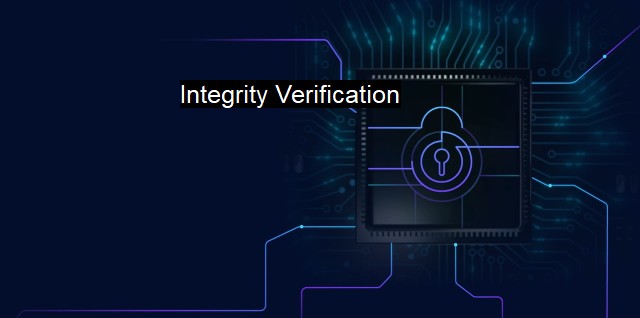What is Integrity Verification?
The Importance and Challenges of Integrity Verification in Modern Cybersecurity: Maintaining Data Integrity and Security amidst Digital Threats and Malicious Actors
In the context of cybersecurity and antivirus systems, 'integrity verification' refers to methodologies and tools that administrators or automated systems utilized to ensure and demonstrate that data has remained unchanged and consistent during its life cycle. Fundamental to trusted information systems, integrity as one of the three pillars, along with confidentiality and availability, which make up the CIA triad guiding principle of cybersecurity.Integrity Verification is paramount for securing infrastructural networks and protecting sensitive information in an age where businesses and public bodies rely profoundly on digitized data. integrity verification confirms that data are genuine, visibly consistent, and shows no signs of modification since it lastly underwent authorized changes.
Every-bit critical in antivirus programs and cryptographic systems, 'integrity verification' essentially operates by comparing the current state of data with a known benign version of the same. In the balance of data lies the security and smooth running of all systems that directly or indirectly rely on the credibility and authenticity of such information.
Let's take encryption and decryption processes, for instance, here whether the recipient information is the same as the sender's intended message fulfills the purpose for using them. Hence, ensuring integrity is crucial in minus active interceptions, hashing performed on data at sender's end is compared with hashing performed on the recipient's end. If imaginary discrepancies arise, it indicates violation of integrity.
Role of integrity verification might be unsung, yet cooperative anomalies detection is the arithmetic heart of nearly every antivirus applications these days. Like a silent observer, these programs routinely scan tokens of data, digital signatures, pertaining to them in pursuit of finding unusual activities or unauthorized changes in the digital materials. Integrity verification in cybersecurity also safeguards against incidents like data tampering, where data is illicitly manipulated causing reputation damage, financial loss, or holding the data captive until a ransom is paid.
One more aspect inclusive in integrity verification strategy within antivirus tools is to look after system faults or disk errors that can affect data. Disk failures, for instance, could modify or erase data and rendering the data or even the entire application unusable should be looked-after for proactive steps to prevent or rapidly remedy disk errors, likewise forms a part of integrity verification.
Talking relatively, ransomware attack one of the most prominently faced security threats today ends up encrypting an user's data and then demands a ransom to restore it. Striking hypothetically an antivirus application has equipped a robust integrity checking system that sensed when data began to be illicitly encrypted. The system could have stopped the malicious activity forcing perpetrations to stop, exposing fewer data and possibly no significant harm.
Hashing and digital signatures fall under the cryptographic techniques most commonly used to verify data integrity. Hash functions compute unique string value and even a microscopic change in input data substantially changes the output hash, enabling precise detection of unapproved changes. On contrast, digital signatures offer an even robustened level of security as they uniquely identify and link the party responsible for the data modifications along with time-stamp.
Therefore, encompassing diligent attention towards integrity verification is perceivably worth the effort and investment. Compromises with data integrity may mean gambling with an organization's future stakes. It's crucial to remember that stringent defense measures are perceivably pointless if they are backed with a weak core of outdated antivirus or integrity mechanisms potentially exposing exploits for manipulation.
With the prolific induction of digitization across various fields, from eCommerce to infrastructure technology, phishing scams to state-sponsored digital offensives, the need for firm data integrity measures is more potent than ever. Integrity verification being the principal element in this could mitigate risk of breaches, save from costly intermissions in service, ensure adherence to regulations and establish better trust between businesses and their customers. Noel Coward has rightly coined "The higher the building, the lower the morals" - data integrity should be treated as part of supporting pillars forafter in the digital infrastructure to cushion evolving cybersecurity challenges.

Integrity Verification FAQs
What is integrity verification in cybersecurity?
Integrity verification in cybersecurity refers to the process of verifying the integrity of digital data and making sure it has not been tampered with or modified without authorization.Why is integrity verification important in antivirus software?
Integrity verification is an important feature of antivirus software because it ensures that the antivirus program and its components have not been modified or compromised by malware.How does integrity verification help prevent cybersecurity attacks?
Integrity verification helps prevent cybersecurity attacks by detecting any unauthorized modifications to digital data or files. By ensuring the integrity of software and data, it also helps prevent malware from accessing or infecting systems.What are some common techniques used for integrity verification?
Some common techniques used for integrity verification include checksums, digital signatures, hash functions, and file verification tools. These methods can help verify the authenticity and integrity of digital data and files.| | A | | | B | | | C | | | D | | | E | | | F | | | G | | | H | | | I | | | J | | | K | | | L | | | M | |
| | N | | | O | | | P | | | Q | | | R | | | S | | | T | | | U | | | V | | | W | | | X | | | Y | | | Z | |
| | 1 | | | 2 | | | 3 | | | 4 | | | 7 | | | 8 | | |||||||